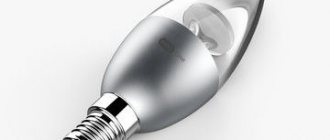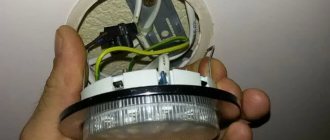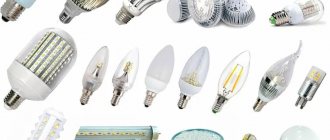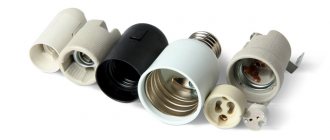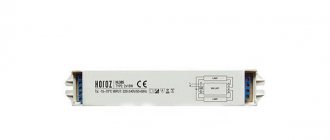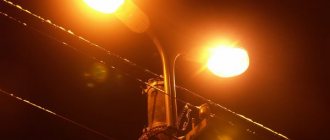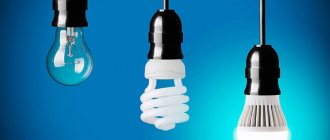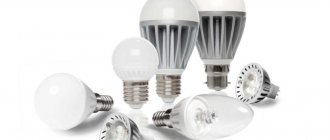Well, guys, it’s time to talk about the next type of base, namely the E14 modification. We talked about E27 In this article. This smaller version is now very widely used in various bot devices and equipment. I must say thank you to LED technology; it is their use in lighting that practically eliminates the importance of the size of the base. However, today we will talk specifically about E14, so if you are looking for information, read it, you won’t regret it...
First, a little definition
base (or ES in the USA and Europe) is the younger brother of the E27, appeared much later and was designed for small lighting fixtures and chandeliers. It got its name because of the size - 14 is the diameter in millimeters, but the letter “E” denotes the screw type (invented by Edison - Edison Screw).
As a rule, incandescent lamps with such an “end” were not powerful, the maximum versions reached only 40 watts and were used in various household appliances, such as refrigerators, stoves, etc. It was also widely used in all kinds of lamps and chandeliers . Often, in order to achieve a normal level of illumination, at least 6 and at most 18 pieces were placed in a chandelier. They were often combined with the “E27”
Features and Specifications
E14 bulbs are the most common along with E27. They are suitable for most types of miniature lamps, and the price of lamps varies from 10 to 20 rubles.
The devices are easy to operate, do not cause difficulties when replacing the cartridge, and consumption is low. Designed to work with a voltage of 220 Volts.
There are LED analogues that use the E14 socket. They are not very powerful, but the level of luminous flux is higher than for sources with filament. E14 diode bulbs are compact, so they are used even for recessed luminaires.
Areas of application
The human eye responds best to sunlight. Therefore, the closer the light emitted by an electric lamp is to natural, the more comfortable we feel during a long working day. It is the LED E14 lamp, thanks to its soft light, that can significantly reduce eye strain and thereby protect a person from rapid fatigue.
Creation of general lighting in residential premises, organization of complex industrial, emergency, street lighting, use as obstruction lights, creation of various types of lighting - in all these areas it is possible to effectively use energy-saving LED lamps E14.
Today, E14 LED lamps, the price of which ranges from 100 to 150 rubles, are available to the majority of consumers. Such lamps are installed in almost all major retail chains, public and entertainment establishments. Entrepreneurs understand that it is more profitable to install LED lighting at an affordable cost than to once again burden themselves with constant maintenance and replacement of standard incandescent lamps.
What types of lamps are there with this type of base and where are they used: features and parameters
E14 socket is used in incandescent, fluorescent, halogen and LED lamps. All of them are used in lighting devices, for illuminating refrigerators or microwave ovens. Bulbs of different types of E14 base will differ in size - products with incandescent filament are the smallest. Therefore, when purchasing devices, you should understand that they will look different in a chandelier.
The E14 also differs in shape. The most common type of light bulb is the “Candle”, which is used in ceiling chandeliers. Products in the shape of “Candle in the Wind” are installed in sconces - the top of the bulb is slightly elongated and curved.
“Fire flames” are more expensive and less popular forms of light bulbs. According to the manufacturer's idea, the bulb should be visible, so it makes no sense to use it in lighting fixtures with a lampshade.
Forms
And in conclusion, I would like to say that it was precisely these lamp options that received design developments that went into series. For example, you can buy a “ candle in the wind ”, “flickering fire”, etc.
Now let's watch a short video.
That's all, I think I've helped you. Read our construction site.
Advantages and disadvantages of use
The main advantages of light bulbs with E14 base:
- mass production of the product;
- low cost of products with filament;
- suitable for almost all lamps;
- low energy consumption (about 40 W);
- variety of forms;
- E14 base is used in all types of lamps - fluorescent, incandescent, LED, halogen, energy-saving analogues.
Flaws:
- The maximum power is only 60 W.
Separately, it is worth considering LED devices, because it is to them that the active transition occurs.
Advantages of diode light bulbs:
- low energy consumption compared to incandescent lamps;
- standard service life is 4-5 years;
- absence of harmful components in the composition;
- ease of disposal;
- the ability to repair devices if they break down;
- do not warm up;
- they are stronger than fragile incandescent lamps;
- wide range of color temperatures.
Minuses:
- to organize bright lighting, many light bulbs are required due to their low light output;
- high price;
- there are a large number of fakes on the market that do not meet the stated requirements;
- excess temperature is dangerous for the operation of diodes;
- The size of LED lamps is larger than conventional ones.
Important! Since LED lamps do not heat up, they can be used to organize lighting on suspended ceilings.
Edison base
The Edison socket is a screw mechanism that was developed by Thomas Edison specifically for mounting incandescent lamps. Since then they have been produced with threaded bases of different diameters. In the designation, “e” means screw type, and the number is the diameter in mm. E14 is one of the most common household bases in Russia.
Design
Device
Structurally, the base is similar to a cylinder with a thread with a diameter of 14 mm. It is made of aluminum. There is a contact at the top. An electrode is attached to it, which leads to the filament body. The second electrode from the tungsten helix is attached to the thread of the base.
There is a hollow glass insulator inside. It is necessary for pumping out air and pumping inert gases and buffer mixtures into the flask. The insulator is present only in incandescent and halogen lamps. Other types have a similar base design.
It is important to connect the wires to the socket correctly. In the event of an error, there is a risk of electric shock to a person
To avoid this, the phase wire is connected to the base contact, and the neutral wire is connected to the screw thread.
Electrical connection
E14 sizes are standard.
Dimensions
Marking
For “Edison screw” type bases, the EXX marking is accepted, where:
- E – indicates the type (Edison Screw type);
- XX - numbers indicating the diameter, for example, the type of light bulb E14, indicates that the diameter of the base is 14 mm, that is, the difference between types E14 and E27 lies in the width of the socket.
Note that to ensure compatibility, special adapters are produced, for example, an adapter from E27 to E14 socket.
Thanks to such conductors, it becomes possible to install incandescent lamps of a standard size (E27) (as well as their energy-saving analogues) in a socket for a minion (E14).
The use of lamps with a minion base
Devices with an E14 socket are produced for the home, where they are used as sources of general or local lighting; in addition, such lamps can serve as backlight in various household appliances (for example, a lamp for a refrigerator).
Gradually, incandescent lamps are being replaced by energy-saving analogues; sources designed for use in minion-type cartridges are no exception. But when choosing them, it is necessary to take into account that the dimensions of energy-saving lamps are not so compact, so it may happen that they do not fit into the shades of some chandeliers or sconces.
The second factor limiting the use of energy-saving lighting sources for both E27 and E14 bases is their relatively high price. Currently, incandescent lamps are cheaper, but according to experts1, this situation will improve for the better in the near future.
It should be noted that thanks to the development of online trading, the cost of lamps is approximately the same in all cities of Russia, for example, in Moscow and Yekaterinburg the price is practically the same.
Marking
The sockets are marked as follows - first there is a letter, then 2 numbers. The following types exist:
- B – pin;
- E – threaded, also called Edison base;
- G – pin;
- R – with recessed contacts;
- P – with focusing contacts;
- S – soffit;
- T – telephone connection;
- K – cable connection;
- W – baseless.
The number is the thread diameter in millimeters. To ensure compatibility, adapters have been created that allow you to install a lamp with an e27 base on an e14. Thanks to special adapters, you can install standard incandescent lamps in a socket with an E14 thread.
Explanation of marking values
For a simpler understanding of the design features and technical characteristics, all existing modifications of LED lamps are divided according to the generally accepted classification. Devices are marked according to their intended purpose, type of base and device.
Marking is applied to the packaging taking into account established standards. After studying it, you can quickly get a clear idea of the capabilities of the device you are interested in.
The marking shows:
- power and brightness;
- maximum periods of continuous operation;
- degree of energy efficiency;
- flask variation;
- range of permissible operating temperatures;
- level of color rendering quality.
One of the main criteria that is used when choosing is the type of base.
The base is the most important part of the device, since it is responsible for the tightness of adhesion of the contacting metal elements and the quality of interaction with the electrical power circuit.
Any damage to the base makes the equipment sensitive to the slightest changes in current and voltage parameters. This threatens serious interruptions in the operation of the lamp, which will soon lead to complete failure
Soffit sockets are marked with the letter “S”, recessed contacts with “R”, pin contacts with “B”. Devices with a standard threaded connection, characteristic of conventional incandescent lamps, are assigned the letter “E”.
This symbol was chosen as a marking for a reason. It is borrowed from the name of the designer of the design - the famous inventor in the field of lighting technology, Edison.
LED light bulbs with the designation E14 are called “minions”. They differ from the common modification E27 only in the size parameters of the base.
The number next to the letter determines the diameter of the contacts, measured in millimeters. The connection of the light bulbs in question is 14 mm.
What to consider when choosing an e14 lamp
When choosing a light bulb for a lamp, you need to consider the following important parameters:
- power;
- sizes, shape;
- company manufacturer;
- optimal mains voltage.
When purchasing the product, you should inspect the integrity of the product. If scratches or unreliable contacts are found, such a light bulb cannot be taken.
When choosing an LED device, you need to pay attention to:
- Glow efficiency. This parameter shows how much luminous flux the light bulb produces per 1 watt. The efficiency of diode products ranges from 60 to 80 lm/W.
- Glow power. It can be compared with the indicator of an incandescent lamp using special tables.
- Colorful temperature. The shade of the glow depends on it. It is selected depending on the purpose - for example, when used in a residential area, it is better to give preference to warm colors. For offices, light bulbs are purchased in neutral white shades. Cool colors can be used in industrial areas. Color temperature is measured in Kelvin (K). Warm white shades are in the range of 2700-3500 K, neutral – 3500-4000 K, cold – 5500-6000 K.
- Mains voltage. LED devices operate either from a 220 V network or from a 12 V power source. Devices with socket e14 and e27 can operate on direct and alternating voltage.
- Color rendering index. Measured in the range from 0 to 100. High-quality display of the color gamut is available with an index of 98 and higher. Below 80, color distortion occurs.
- Direction of light, angle of illumination. Depending on the shape, the radiation pattern and, accordingly, the direction of illumination differ.
- Ability to control brightness. This is an additional feature; these lamps have dimmers that allow you to change the brightness.
- Ripple factor. Flickering light negatively affects the eyes and nervous system, so for health safety you should buy products with low pulsation. SNIP recommends purchasing devices with a coefficient of 5-20%. Flickering lamps are usually produced by little-known companies that sell products at low prices.
- Date of manufacture. Models older than two years may be significantly inferior to the latest products in terms of their characteristics.
- Warranty, service life.
How to disassemble an e40 LED lamp
As mentioned above, led e40 differs from e27 mainly in size. Therefore, disassembling such a lamp is no more difficult than the usual E27.
LED design
First you need to remove the diffuser. If it is not glued with sealant, then simply carefully twist it and remove it.
If the diffuser has latches, then use a sharp knife or awl to carefully move around the circumference of the joint until you hit the latch. After this, use a knife to carefully bend the latch and remove the diffuser
If the diffuser is glued with sealant, you will need a solvent (not acetone!), an awl and a syringe with a needle. The awl needs to be drawn over the place where the diffuser is attached.
Then carefully pour the solvent drop by drop from the syringe into the remaining well. Wait five minutes: the solvent will soften the sealant
Then carefully rotate the diffuser and remove it.
After removing the diffuser, you need to remove the board with the LEDs and take out the driver. If the board has screws, use a screwdriver to unscrew them. If it is glued with sealant, then cut around the circumference with a sharp knife and remove the board by prying it off with a knife.
Schematic diagrams of LED lamps
The reliability of LED lamps depends on the quality of the parts and their assembly. The most important component is the driver.
In its simplest form, it consists of a capacitor and a voltage rectifier. A resistor is used as a current limiter. The circuit is elementary, contains a strictly defined number of LEDs. This lamp can be easily repaired at home. But the light from such a source is pulsating and has a short service life.
Electrical circuit of a simple driver
A more complex driver version contains:
- a bridge voltage rectifier, which limits the input current through a capacitive balance;
- several capacitors;
- system for regulating current and voltage parameters;
- coupling circuit for dimming (not available for all models).
Driver circuit diagram
Moreover, the “goliath” for a “complex” driver plays a positive role: in a large lamp, all the above-described components are located without problems. (The same cannot be said about small LED light sources).
The driver of a complex design helps to shine with even light and work for a long time. However, such products cost more and are difficult to repair.
There are many intermediate electrical circuits. The design should be chosen based on the purpose of the light source: for night illumination of deserted spaces, a light source with a simple driver is sufficient.
Chuck device
In most cases, the e14 electric cartridge is attached to the lamp using the bottom. There is a hole for the cable. There are models with pin fastening to the lamp, classic screwing and combined fastening (when the light bulb is placed in part of the socket and then screwed in). It is interesting to note that elements with a rotary-threaded connection are complex, but irreplaceable, since they are constantly subject to physical and mechanical stress.
You may be interested in this Features of smart light bulbs
Today, you can attach the base to the lighting equipment by the conductive wires, using a tube, contact clamps and a sleeve.
For current-carrying wires
A plastic sleeve is placed at the bottom of the E14, which has a central hole for the cable. Next, the plastic screw is installed, the base is connected and the wires are clamped with the screw. As a result, the base is securely fixed.
Device for current-carrying wires
On the phone
The base on the tube is attached thanks to nuts, with the help of which the fittings for the chandelier with caps are installed. The entire load falls on the tube. Wires for lighting pass through it. The threaded sockets can then be decorated with lampshade rings or other decorative elements.
Device on the tube
Bushing
Bushing is a device for securing sockets in light bulbs with wall sconces. It is made from sheet materials. A hole is made to attach the E14 base
It is important to note that plastic bushings are not used, since the light sources in them are deformed. Metal models should be used
Mounting threads vary, so there are no standards.
Note! To replace the plastic sleeve, you should use a resistor. Before breaking, you should disassemble and compare the threads
Bushing device
With screwless terminals
The cartridge case with the e14 bottom, which uses screwless types of clamping contacts, is connected by latches. The bottom is screwed onto the threaded tube and then the electrical wires are made. The body is created in the form of a cylinder and attached to part of the bottom. E14 elements can be repaired and serviced independently at any time.
Device with screwless terminals
The e14 electric socket is the most common lighting fixture socket. It has a low price, ease of operation and a wide color range. It does not heat up and does not contain harmful substances.
Comparison with e27
The difference between the E27 and E14 bases is the size.
For e27, the diameter of the threaded connection is 27 mm, and for e14 the height and diameter are 26 and 14 mm, respectively.
The energy consumption of light bulbs does not depend on the type of base.
In LEDs with similar bases, there will also be a difference in the angle of illumination, on which the illuminated area depends. For e14 the angle is 360 degrees, for e27 this value is less.
Popular manufacturers
If you don’t know which brand of LED lamps is best to buy, then choose products from well-known brands. In this case, the risk of purchasing a low-quality model will be significantly lower.
Best manufacturers:
- Camelion (Germany);
- Gauss (RF);
- ASD (China);
- Philips (Netherlands);
- ERA (RF);
- OSRAM (Germany);
- Remez (Germany);
- Sweko (RF);
- IEK (RF);
- HIPER (China);
- SmartBuy (China);
- Uniel (China).
